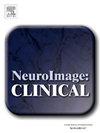Adults with down syndrome exhibit altered somatosensory cortical inhibition
IF 3.6
2区 医学
Q2 NEUROIMAGING
引用次数: 0
Abstract
Down syndrome (DS) is a developmental genetic disorder that is associated with an accelerated aging profile and high probability of early incidence Alzheimer’s disease like symptoms. It is well established that there are morphological differences in the brains of adults with DS, but the net impact of the genetic disruption on cortical function remains poorly understood. To address this knowledge gap, we used magnetoencephalographic (MEG) brain imaging to assess the somatosensory cortical activity elicited by a paired-pulse electrical stimulation of the right median nerve of adults with DS (N = 19; Age = 28.05 ± 7.9 yrs.) and neurotypical controls (NT) (N = 21; Age = 30.81 ± 8.2 yrs.). sLORETA was used to image neural responses to the somatosensory stimulation, which were centered on the left central sulcus posterior to the motor hand knob region. Our results revealed that adults with DS had weaker somatosensory cortical activity after the second electrical stimulation in the paired-pulse paradigm (DS = 594.1 ± 194.22 AU; NT = 750.48 ± 256.6; P = 0.038) and a pronounced hyper-gating response (DS = 78.9 ± 6.8 %; NT = 87.4 ± 9.9 %; P = 0.003). Together, these results suggest that adults with DS may have an imbalance in the excitatory/inhibitory ratio. These novel data enhance our understanding of the neurophysiological aberrations associated with DS and may hold promise in understanding the origins of Alzheimer’s disease like symptoms in this population. Future studies should examine whether these inhibitory alterations are restricted to the sensorimotor cortices or extend across the brain.
患有唐氏综合症的成年人表现出改变的体感觉皮层抑制
唐氏综合症(DS)是一种发育性遗传疾病,与加速衰老和早期阿尔茨海默病样症状的高发生率有关。已经确定的是,成人退行性椎体滑移患者的大脑存在形态差异,但遗传破坏对皮质功能的净影响仍然知之甚少。为了解决这一知识差距,我们使用脑磁图(MEG)脑成像来评估成对脉冲电刺激成人退行性椎体变性右正中神经所引发的体感觉皮层活动(N = 19;年龄= 28.05±7.9岁)和神经正常对照组(NT) (N = 21;年龄= 30.81±8.2岁)。用sLORETA成像对体感刺激的神经反应,这些反应集中在运动把手区后的左侧中央沟。结果显示,成人退行性椎体退行性椎体退行性椎体退行性椎体退行性椎体退行性椎体退行性椎体退行性椎体退行性椎体退行性椎体退行性椎体退行性椎体退行性椎体退行性椎体退行性椎体退行。nt = 750.48±256.6;P = 0.038)和明显的超门控反应(DS = 78.9±6.8%;nt = 87.4±9.9%;p = 0.003)。综上所述,这些结果表明成人退行性痴呆可能存在兴奋/抑制比例失衡。这些新数据增强了我们对与退行性痴呆相关的神经生理异常的理解,并可能为理解这一人群中阿尔茨海默病症状的起源带来希望。未来的研究应该检查这些抑制性改变是局限于感觉运动皮层还是扩展到整个大脑。
本文章由计算机程序翻译,如有差异,请以英文原文为准。
求助全文
约1分钟内获得全文
求助全文
来源期刊

Neuroimage-Clinical
NEUROIMAGING-
CiteScore
7.50
自引率
4.80%
发文量
368
审稿时长
52 days
期刊介绍:
NeuroImage: Clinical, a journal of diseases, disorders and syndromes involving the Nervous System, provides a vehicle for communicating important advances in the study of abnormal structure-function relationships of the human nervous system based on imaging.
The focus of NeuroImage: Clinical is on defining changes to the brain associated with primary neurologic and psychiatric diseases and disorders of the nervous system as well as behavioral syndromes and developmental conditions. The main criterion for judging papers is the extent of scientific advancement in the understanding of the pathophysiologic mechanisms of diseases and disorders, in identification of functional models that link clinical signs and symptoms with brain function and in the creation of image based tools applicable to a broad range of clinical needs including diagnosis, monitoring and tracking of illness, predicting therapeutic response and development of new treatments. Papers dealing with structure and function in animal models will also be considered if they reveal mechanisms that can be readily translated to human conditions.
 求助内容:
求助内容: 应助结果提醒方式:
应助结果提醒方式:


